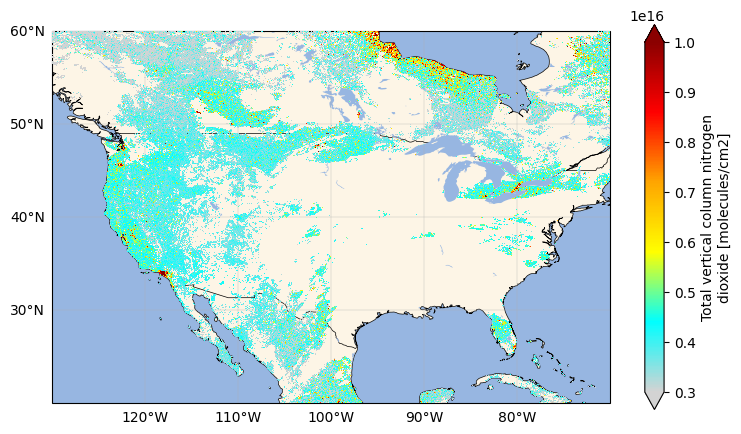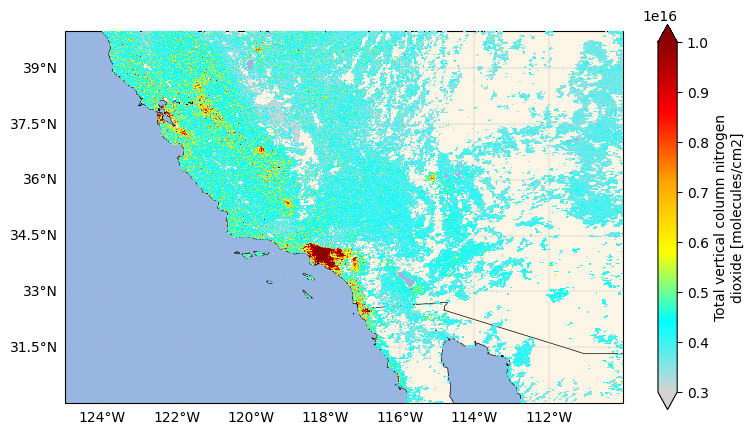Exploring nitrogen dioxide (NO2) data from PACE/OCI#
Author(s): Anna Windle (NASA, SSAI), Zachary Fasnacht (NASA, SSAI)
Last updated: July 28, 2025
The following notebooks are prerequisites for this tutorial.
Summary#
This tutorial describes how to access and download nitrogen dioxide (NO2) data products developed from PACE OCI data. More information on how these products were created can be found in Fasnacht et al. (2025). This notebook will also include examples on how to plot NO2 data as a static and interactive map, as well as how to plot an interactive time series plot.
Learning Objectives#
At the end of this notebook you will know:
Where to access NO2 data products in development for the PACE Mission at the NASA Aura Validation Data Center
What to select from the XArray
DataTreeobjects representing hierarchichal datasetsWhere to find high NO2 vertical column retrievals (hint: it’s a big city)
How to create a time series of NO2 data collected at a single location
1. Setup#
Begin by importing all of the packages used in this notebook. If you followed the guidance on the Getting Started page, then the imports will be successful.
from datetime import datetime
import cartopy
import cartopy.crs as ccrs
import cartopy.feature as cfeature
import fsspec
import hvplot.xarray
import matplotlib.colors
import matplotlib.pyplot as plt
import pandas as pd
import xarray as xr
import holoviews
holoviews.config.image_rtol = 1e-2
swap_dims = {"nlon": "longitude", "nlat": "latitude"}
2. Download NO2 Data#
While under development, the NO2 product is available at
NASA’s Aura Validation Data Center
(AVDC). While the data are hosted there, we can access files from this site using the fsspec package. Once this product is implemented by the PACE Mission Science Data Segment (SDS), it will be available in the Earthdata Cloud and accessible as usual using the earthaccess package.
url = "https://avdc.gsfc.nasa.gov/pub/tmp/PACE_NO2/NO2_L3_Gridded_NAmerica/PACE_NO2_Gridded_NAmerica_2024m0401.nc"
fs = fsspec.filesystem("https")
path = fs.open(url, cache_type="blockcache")
3. Preview this hierarchical dataset#
We will use xarray.open_datatree to open all groups in the NetCDF and then merge them into a single dataset. We need to clean up some superfluous data stored as nlat and nlon along the way.
datatree = xr.open_datatree(path)
datatree["/"].dataset = datatree["/"].dataset.drop_vars(swap_dims)
dataset = xr.merge(datatree.to_dict().values()).swap_dims(swap_dims)
dataset
<xarray.Dataset> Size: 128MB
Dimensions: (longitude: 4000, latitude: 2667)
Coordinates:
* longitude (longitude) float32 16kB -130.0 ....
* latitude (latitude) float32 11kB 20.01 ......
Data variables:
nitrogen_dioxide_total_vertical_column (longitude, latitude) float32 43MB ...
U10M (longitude, latitude) float32 43MB ...
V10M (longitude, latitude) float32 43MB ...
Attributes:
title: PACE OCI Level-3 Data NO2
product_name: PACE_NO2_Gridded_NAmerica_2024m0401.nc
processing_version: 1.0.0
Conventions: CF-1.8
instrument: OCI
date_created: 2024-12-19T12:36:59.110439
institution: NASA/GSFC
spatial_resolution: 1500m
spatial_coverage: -130W to -70W, 20N to 60N
date: 2024-04-01T00:00:00.000000
PlatformShortName: PACEIf you expand the nitrogen_dioxide_total_vertical_column variable, you’ll see that it is a 2D variable consisting of total vertical column NO2 measurements with units of molecules cm-2.
Let’s plot it!
fig, ax = plt.subplots(figsize=(9, 5), subplot_kw={"projection": ccrs.PlateCarree()})
ax.gridlines(draw_labels={"left": "y", "bottom": "x"}, linewidth=0.25)
ax.coastlines(linewidth=0.5)
ax.add_feature(cfeature.BORDERS, linewidth=0.5)
ax.add_feature(cfeature.OCEAN, linewidth=0.5)
ax.add_feature(cfeature.LAKES, linewidth=0.5)
ax.add_feature(cfeature.LAND, facecolor="oldlace", linewidth=0.5)
cmap = matplotlib.colors.LinearSegmentedColormap.from_list(
"",
["lightgrey", "cyan", "yellow", "orange", "red", "darkred"],
)
dataset["nitrogen_dioxide_total_vertical_column"].plot(
x="longitude", y="latitude", vmin=3e15, vmax=10e15, cmap=cmap, zorder=100
)
plt.show()

Let’s zoom in to Los Angeles, California … i.e., the bright red blob in the lower left.
fig, ax = plt.subplots(figsize=(9, 5), subplot_kw={"projection": ccrs.PlateCarree()})
ax.gridlines(draw_labels={"left": "y", "bottom": "x"}, linewidth=0.25)
ax.coastlines(linewidth=0.5)
ax.add_feature(cfeature.BORDERS, linewidth=0.5)
ax.add_feature(cfeature.OCEAN, linewidth=0.5)
ax.add_feature(cfeature.LAKES, linewidth=0.5)
ax.add_feature(cfeature.LAND, facecolor="oldlace", linewidth=0.5)
dataset["nitrogen_dioxide_total_vertical_column"].plot(
x="longitude", y="latitude", vmin=3e15, vmax=10e15, cmap=cmap, zorder=100
)
ax.set_extent([-125, -110, 30, 40])
plt.show()

You’ll also see other variables in the dataset U10M, and V10M.
These are 10-meter Eastward Wind, and 10-meter Northward Wind, respectively.
4. Interactive NO2 plot#
An interative plot allows you to engage with the data such as zooming, panning, and hovering over for more information. We will use the hvplot accessor on XArray data structures to make an interactive plot of the single file we accessed above.
dataset["nitrogen_dioxide_total_vertical_column"].hvplot(
x="longitude",
y="latitude",
cmap=cmap,
clim=(3e15, 10e15),
aspect=2,
title="Total vertical column NO₂ April 2024",
widget_location="top",
geo=True,
coastline=True,
tiles="EsriWorldStreetMap",
)
